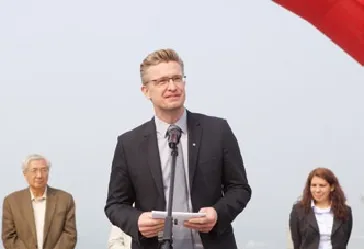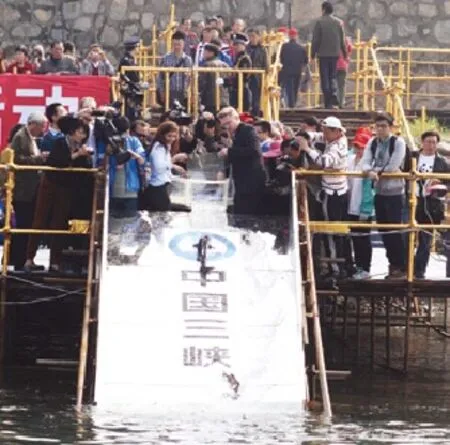汉斯:做好水资源开发中的生态保护
汉斯:做好水资源开发中的生态保护
Make Efforts for Better Eco-protection in Water Resources Development
记者/吴冠宇 译/朱 丹 编辑/李颜岐
我们必须有效整合水与能源的联系,秉持环境友好和可持续发展的理念,履行大型企业的生态环境保护责任,在水资源的开发中做好生态保护。
《中国三峡》:在2014年3月22日世界水日到来之时,联合国发布了一份《世界水发展报告2014:水与能源的联系》,将目光集中在水与能源之间相互依赖的关系上。在这份报告中,它提到了我们必须更加清晰地理解资源间的复杂关系,并且更加有效地整合水与能源之间的联系使其成为促进可持续发展的积极手段。
您如何看待水与能源之间的联系,尤其是水与水力发电?能否就如何更加有效地整合水与能源之间的联系使其成为促进可持续发展的积极手段给出您的建议或看法?
汉斯:联合国《世界水发展报告2014》(WWDR 2014)指出,全球大约90%的电力生产为水资源密集型。当考虑水与能源之间的联系时,我们会很自然地联想到水电。但是,我们也要记住很重要的一点,就是水被直接利用于几乎各种形式的电力生产之中。这种水与能源的直接联系及其相关成本有时会在讨论中被忽视,如燃煤发电。
值得注意的是,水力发电及其水库的运营为水资源可持续利用做出了许多积极贡献。其储水可抗旱、支持洪水管理、改善航运条件,并提供休闲娱乐活动。然而,这些直接与水电相关的不同的水资源利用方式都需要谨慎管理。在一年中的不同时段,下泄水量会因用途不同而产生需求上的改变,并非总是均衡不变的。
不过,大型水电工程总是经常会陷入争议,如其对环境和生物多样性的影响、导致文化和历史遗迹的遗失及其产生的社会冲击。在这方面,通过在新式基础设施建设和规范已有基础设施中解决整体系统健康的可持续性大坝管理方法,已累积了一些能缓解这些负面影响的积极经验。
《世界水发展报告2014》第二卷中三峡工程的案例研究,突出了在中国背景下的这些挑战,及最高决策层为减缓这些雄心勃勃的发展项目对社会、环境的影响而作出的承诺。
在不确定性和风险条件下进行水管理,可以通过革新水的分配、利用和管理获得至关重要的机会和利益。
《中国三峡》:您在庆祝世界水日到来的论坛上推荐了《不确定性和风险条件下的水管理》一文。这篇文章提到针对一些具有不确定性和风险的因素,可以通过革新水的分配、利用和管理获得至关重要的机会和利益。
如何面对这些不确定性和风险因素?在革新水的分配、利用和管理方面您的看法是什么?
汉斯: 第四期的《世界水发展报告》对全球变化性质的多个方面进行了详细讨论——从政治和社会体系到科学技术、生活水平、消费结构、预期寿命等。随着人口增长及越来越多地搬迁到扩张的城市区域,土地使用、覆盖及气候的变化是自然而然的。这些变化和它们日益增长的发生频率及其长期影响,生成了我们必须与之共存的不确定因素和风险。然而,适应变化的过程也提供了机会:过去已发生的无法改变,但现在所做的决定将影响未来。

联合国教科文组织驻华代表处自然科学项目官员Hans Dencker Thulstrup在放流现场发言。 摄影/王绪波
CTG:The United Nations World Water Development Report 2014 focuses on the water and energy. In this report, it mentioned we need to better understand the complex interactions between resources, and better integrate the link between water and energy as positive levers for sustainable development.
What’s your opinion about the interaction between water and energy, especially the interaction between water and hydro-power? What’s your opinion on better integrating the link between water and energy as positive levers for sustainable development?
Hans:The United Nations World Water Development Report 2014 (WWDR2014) notes that approximately 90% of global power generation is water intensive. When considering the linkages between water and energy, we naturally think of hydropower. However, it is important to remember that water is utilized in nearly all forms of energy generation. This direct linkage between water and energy – and the associated cost – is sometimes overlooked when discussing, for example, coal–powered energy generation.
It is important to note that hydropower operations and related reservoirs have a number of positive contributions towards sustainable use of water resources. They provide storage for drought alleviation, support flood management, improve navigation and enhance opportunities for recreation. However, these different uses of water all directly related to hydropower require careful management. At different times of the year, water releases are required for different – and not always aligned –purposes.
At the same time, large-scale hydroelectric are often criticized, for example for damage to the environment and biodiversity, loss of cultural and historical sites, and social disruption. In this regard, positive experiences in the mitigation of these impacts are being made through the adoption of sustainable dam management, which is based on designing new and regulating existing infrastructure to address overall system health.
The Three Gorges project case study included in the second volume of WWDR2014 highlights these challenges in the Chinese context and the commitments made at the highest level to reduce the social and environmental impact of this ambitious development project.
CTG:You introduced the newly completed Chinese translation of volume 1 of the 4th edition UN World Water Development Report on the theme of Managing Water under Uncertainty and Risk at the forum of celebrating World Water Day. This book informs that some forces which create uncertainty and risk can be managed effectively and can even generate vital opportunities and benefits through innovative approaches to allocation, use and management of water.
How to meet with the uncertain and risky forces? What’s your opinion on innovating approaches to allocate, utilize and manage water?
Hans:In the 4th WWDR, the multifaceted nature of global change is discussed in detail –from political and social systems, to technology, living standards, consumption patterns and life expectancies. As human populations grow and increasingly move to expanding urban areas, consequently, land use and cover is changing, as is the climate. These changes, and the manner in which they occur at often increasing rates and their longterm impact, generate the uncertainties and risks that we must live with. However, adapting to change also presents an opportunity: what has happened in the past cannot be changed, but the future can be influenced by the decisions being made now.
减少不确定性最直接的方式之一,就是不断增进和获取对决定当前及未来水资源的量与质知识及理解。要减少不确定性,数据采集、分析能力和预估能力都是必备条件,从而改进分配、使用、调动和处理的决策。作为联合国专门的科学机构,对联合国教科文组织来说,这方面的工作是对解决不确定性和风险的基础性工作。在管理响应方面,适应性管理的策略允许基于新见解的转变和调适,帮助建立和支持灵活的、可容错的机构设置与技术体系,并且提供过程透明的决策框架。
提高水在各方面的利用率(农业、工业及城市)将为可持续的社会经济发展做出贡献。资助多样的蓄水工程,从修建小型雨水蓄水池到大规模水坝,从建立人工含水层补给系统到改善土壤条件以便容纳更多的水,都是可以满足日益增长的蓄水需求的方式。蓄水能确保干旱时期的粮食安全。正如现代消费者以多元化的金融控股方式降低风险一样,小农可以使用一系列“水账户”(如水资源和现代农业技术)来为应对气候变化影响提供缓冲。

2014年4月,三峡集团举办中华鲟春季放流活动,活动吸引公众参与,让大家都来关爱环境、保护中华鲟,培养大众的环保意识。图为一小学生正在运送中华鲟到江边进行放流。摄影/王绪波
三峡工程为长江流域的可持续管理及发展做出了巨大贡献,也对流域环境有着显著影响,如何妥善处理这些问题对于三峡工程的总体可持续性来说将会是一个重大考验。
《中国三峡》:中国长江三峡水利枢纽工程作为目前世界上规模最大的水利枢纽工程,从水资源综合管理和可持续发展的角度您如何评价它?
汉斯: 三峡工程是一项在各个方面都很庞大的工程,从其抱负、成就、影响、象征意义等方面来说都是如此。三峡工程在防洪、航运、补水和发电等方面做出的贡献是不容低估的。通过这些方面,三峡工程为长江流域的可持续管理及发展做出了巨大贡献。然而,三峡工程对流域环境也有着显著影响,有些影响在目前还无法完全预知。因此,在成功缓解了大范围不确定因素和风险的同时,三峡工程自身也带来了新的不确定性因素。
《世界水发展报告2014》的三峡工程案例研究指出了耕地与稀有植物的淹没、长江流域某些支流部分自净能力减弱、库区以及长江中下游区域水生生态系统改变等问题是如何与工程相关联的。三峡集团和中国政府已经相当了解这些问题,如何妥善处理这些问题对于三峡工程的总体可持续性来说将会是一个重大考验。在三峡工程这样的项目上起作用的利弊权衡,成为我们获取关于可持续性水资源管理的新知识,以及做出降低不确定性和风险因素的选择的宝贵资源。
长江流域现在面临着因区域经济迅速增长和随之而来的城市及工业扩张所带来的多重威胁。平衡经济增长需求和自然文化遗产可持续管理之间的关系至关重要。
《中国三峡》:长江流域生态多样性保护工作的重点和难点有哪些?
汉斯:长江流域是全世界最具生物多样性的区域之一,这里被山川、森林、湿地和水道所环绕。同时也是人口密集的大区域以及一些标志性动物物种,比如大熊猫、中华鲟和长江江豚等动物的家乡。该流域也是中华文化历史中心,这里的一些景观与动植物是中国所独有的。
经过历代人类密集地利用,长江流域现在面临着因区域经济迅速增长和随之而来的城市及工业扩张所带来的多重威胁。平衡经济增长需求和自然文化遗产可持续管理之间的关系至关重要。如果长江流域生物多样性缺失,中国的一部分特性也必将随之消失。
One of the most direct ways of reducing uncertainty is to generate new knowledge or understanding of conditions governing water availability and quality in the present and in the future. Data collection, analytical capacity and predictive ability are all required to reduce uncertainty and therefore to facilitate decisionmaking about allocations, uses, mobilization and treatment. To UNESCO, as the UN specialized agency for science, this is an essential contribution towards addressing uncertainty and risk. In terms of management-based responses, adaptive management strategies allow changing course based on new insights, help establish and sustain institutional settings and technological systems that are flexible and error-tolerant, and offer a framework for transparent decision-making processes.
Improving water use efficiency in all sectors (agriculture, industry and municipal) would contribute to sustainable socio-economic development. Funding a diversity of water storage projects, from small-scale rainwater tanks to largerscale dams – and from artificial aquifer recharge systems to improving the soil so it can hold more water –are among the options to meet the ever increasing need for storage. Stored water in times of drought can lead to increased food security. Just as modern consumers diversify their financial holdings to reduce risk, smallholder farmers can use a wide array of ‘water accounts’ (i.e. water sources and modern agricultural techniques) to provide a buffer against climate change impacts.
CTG:China Yangtze Three Gorges Project (TGP) is the biggest hydropower-complex project in the world. How do you evaluate it from the standpoint of integrated water resources management and sustainable development?
Hans: The TGP is an enormous project in every aspect – in terms of its ambition, its achievements, its impact, its influence, and its symbolic significance. The contributions made by TGP in terms of flood mitigation, navigation, drought mitigation and electricity generation cannot be understated. Through these, TGP has made a vast contribution to the sustainable management and development of the Yangtze River Basin. At the same time, TGP has had a significant impact on the Basin’s environment, the effects of which are not yet fully known. Thus, while successfully mitigating a wide range of uncertainties and risks, TGP has at the same time engendered new uncertainties itself.
In the case study of TGP included in the WWDR2014, it is noted how problems associated with the project has included the inundation of arable lands and rare plants; weakened self-purification capacity in certain tributary sections of the river basin; and changed aquatic ecosystems in the reservoir area, as well as in the middle and lower reaches of the Yangtze River. These problems are well known to CTG and the Chinese Government– how they will be addressed will be a significant test of TGP’s overall sustainability. The tradeoffs at play in a project such as TGP make it an invaluable resource for new knowledge about sustainable water management, and the choices we make to mitigate uncertainty and risk.
CTG:What are the key points and threats of biodiversity conservation in the Yangtze River Basin?
Hans: The Yangtze River Basin is among the world’s most biodiverse areas, encompassing mountains, forests, wetlands and waterways. It is also a very large area with a vast human population– as well as the home of a number of iconic animal species, such as the giant panda, the Chinese sturgeon, the Yangtze finless porpoise, and many more. The Basin is central to Chinese culture and history - its landscape, plant and animal life represents something uniquely Chinese.
Subject to intensive human use over generations, the Yangtze Basin is now threatened on multiple fronts due to the region’s rapid economic growth and the associated urban and industrial expansion. Balancing the need for economic growth with the sustainable management of this natural and cultural heritage is crucial. If the biodiversity of the Yangtze River Basin is lost, a part of China’s identity will be lost with it.

图为2014年中国三峡集团举办的中华鲟放流活动现场。 摄影/王绪波
三峡集团在确保环境可持续性方面有着重大的责任,这项责任可以通过环境友好型的企业定位和对科研、环保、教育和公众认识等方面的积极支持来得以落实。
《中国三峡》:三峡集团在生物多样性保护工作中建立了多个稀有物种保护区和研究机构,比如中华鲟研究所。您如何评价三峡集团在生物多样性保护工作方面的努力?作为一个大型企业如何履行生态环境保护责任,您有哪些建议?
汉斯: 作为一家行业重要企业,三峡集团在确保环境可持续性方面有着重大的责任,这项责任可以通过两种主要渠道来得以落实。首先,像三峡集团这样的大型企业,确保所进行的活动将环境可持续性放于第一位是非常重要的。有时,最环境友好型的决策可能并不是最能立即获益的,但从中长期来看是更有益的选择。环境友好型的企业定位,有助于加强企业公众形象,从而为企业带来优势。其次,可通过对科研、环保、教育和公众认识等方面的积极支持来落实责任。正如在中华鲟放流仪式活动中所展示的,来自国内外环境部门的合作方都做好了合作准备。
《中国三峡》:在这次的中华鲟放流仪式活动现场,有许多学生和志愿者积极地参与到这项活动中来。在加强公众环保意识方面,您有什么建议?
汉斯:提高公众的环保意识非常重要,国有和私营企业、大型企业和个体消费者都必须将这项工作视为一己之责。作为主要的电力生产者和对环境有着深远影响与益处的标志性人工建筑的拥有者,三峡集团拥有得天独厚的优势来呼吁公众参与到环境保护中来,通过利用其自身的显著地位让人们关注消费的环境成本,并引导人们做出能缓解人类活动对环境造成负面影响的选择。我们每个人的选择能造成改变,如中华鲟放流仪式这样的活动,对激励年轻人积极主动地保护环境并致力于做出积极改变起到了至关重要的作用。
【受访者简介】
Hans Dencker Thulstrup,联合国教科文组织驻华代表处自然科学项目官员。
CTG:As we know, CTG has established several rare species reserves and research institutions, for example the Chinese Sturgeon Research Institution. How do you evaluate its efforts? And what’s your suggestion about performing responsibility of ecological conservation as a large enterprise?
Hans: As a major corporation, CTG has a big responsibility in terms of ensuring environmental sustainability. This responsibility may be addressed through two main channels. Firstly, it is important for a corporation like CTG to ensure that the choices it makes in the way it conducts its activities prioritizes environmental sustainability. Sometimes, making the most environmentally friendly choice may not seem the most immediately profitable step– however, this may well be the case in the medium and long term. Orienting business practices in an environmentally friendly manner may also help strengthen a corporation’s public image, which in turn yields advantages. Secondly, the responsibility should be addressed through active support towards research, environmental protection, education and public awareness. As the Sturgeon Release Ceremony demonstrates, a wide range of partners from the environmental sector both domestically and internationally are ready to collaborate.
CTG:Many students and volunteers participate in the Chinese Sturgeon Release Ceremony every year. What’s your suggestion for raising public awareness of environmental protection?
Hans:Raising public awareness of environmental protection is crucial, and must be seen as the responsibility of all – the public as well as the private sector, large corporations and individual consumers alike. As a major power producer and the owner of an iconic man-mad structure with wide-reaching environmental impacts as well as benefits, CTG is uniquely placed to engage the public in environmental protection – making use of its highly visible position to draw attention to the environmental costs of consumption, and the choices we can make to mitigate the negative impacts of human activity on the environment. The choices we make as individuals make a difference – events such as the sturgeon release ceremony play a crucial role in inspiring young people to become active in protecting their environment, and in committing themselves to make a positive difference.
——三峡工程

